2019 KIA K900 manual transmission
[x] Cancel search: manual transmissionPage 277 of 580
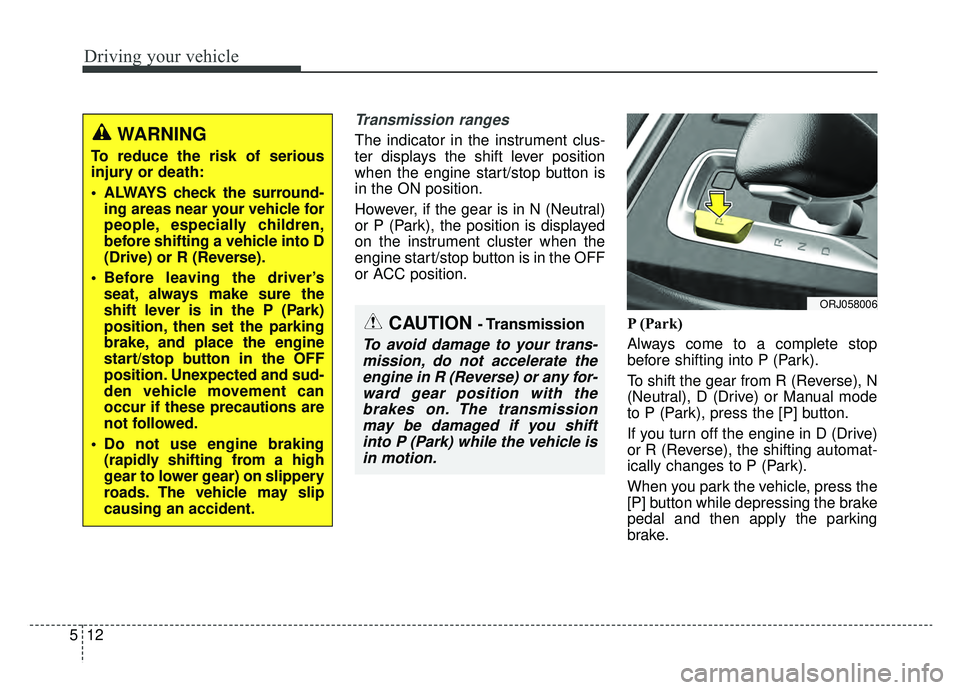
Driving your vehicle
12
5
Transmission ranges
The indicator in the instrument clus-
ter displays the shift lever position
when the engine start/stop button is
in the ON position.
However, if the gear is in N (Neutral)
or P (Park), the position is displayed
on the instrument cluster when the
engine start/stop button is in the OFF
or ACC position.
P (Park)
Always come to a complete stop
before shifting into P (Park).
To shift the gear from R (Reverse), N
(Neutral), D (Drive) or Manual mode
to P (Park), press the [P] button.
If you turn off the engine in D (Drive)
or R (Reverse), the shifting automat-
ically changes to P (Park).
When you park the vehicle, press the
[P] button while depressing the brake
pedal and then apply the parking
brake.WARNING
To reduce the risk of serious
injury or death:
ALWAYS check the surround-ing areas near your vehicle for
people, especially children,
before shifting a vehicle into D
(Drive) or R (Reverse).
Before leaving the driver’s seat, always make sure the
shift lever is in the P (Park)
position, then set the parking
brake, and place the engine
start/stop button in the OFF
position. Unexpected and sud-
den vehicle movement can
occur if these precautions are
not followed.
Do not use engine braking (rapidly shifting from a high
gear to lower gear) on slippery
roads. The vehicle may slip
causing an accident.
ORJ058006
CAUTION - Transmission
To avoid damage to your trans-mission, do not accelerate theengine in R (Reverse) or any for-ward gear position with thebrakes on. The transmissionmay be damaged if you shiftinto P (Park) while the vehicle isin motion.
Page 300 of 580
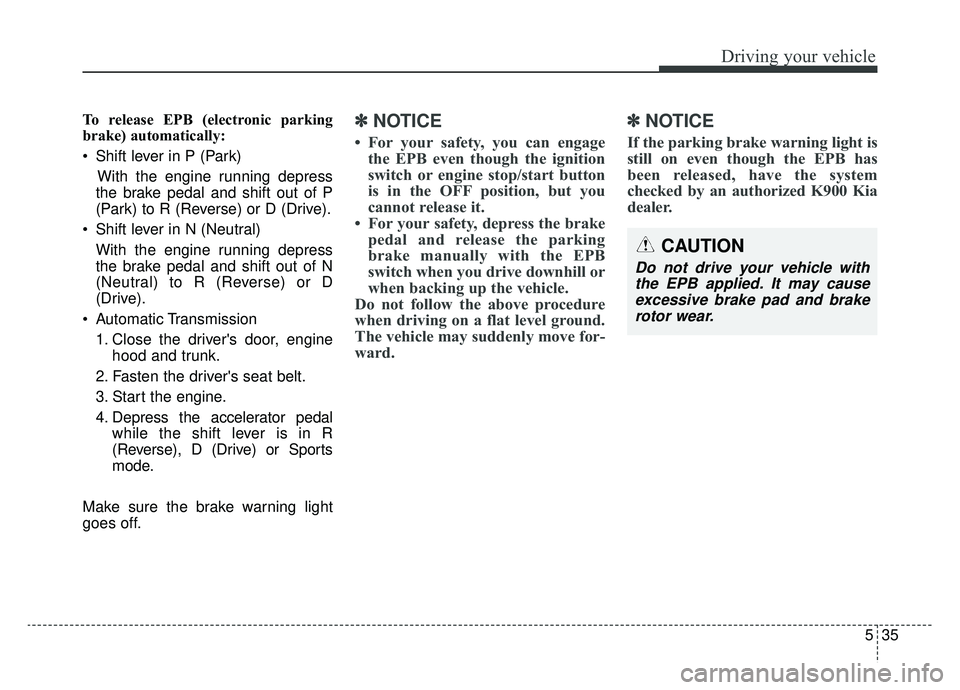
535
Driving your vehicle
To release EPB (electronic parking
brake) automatically:
Shift lever in P (Park)With the engine running depress
the brake pedal and shift out of P
(Park) to R (Reverse) or D (Drive).
Shift lever in N (Neutral) With the engine running depress
the brake pedal and shift out of N
(Neutral) to R (Reverse) or D
(Drive).
Automatic Transmission 1. Close the driver's door, engine hood and trunk.
2. Fasten the driver's seat belt.
3. Start the engine.
4. Depress the accelerator pedal while the shift lever is in R
(Reverse), D (Drive) or Sports
mode.
Make sure the brake warning light
goes off.✽ ✽ NOTICE
• For your safety, you can engage
the EPB even though the ignition
switch or engine stop/start button
is in the OFF position, but you
cannot release it.
• For your safety, depress the brake pedal and release the parking
brake manually with the EPB
switch when you drive downhill or
when backing up the vehicle.
Do not follow the above procedure
when driving on a flat level ground.
The vehicle may suddenly move for-
ward.
✽ ✽ NOTICE
If the parking brake warning light is
still on even though the EPB has
been released, have the system
checked by an authorized K900 Kia
dealer.
CAUTION
Do not drive your vehicle with
the EPB applied. It may causeexcessive brake pad and brakerotor wear.
Page 356 of 580
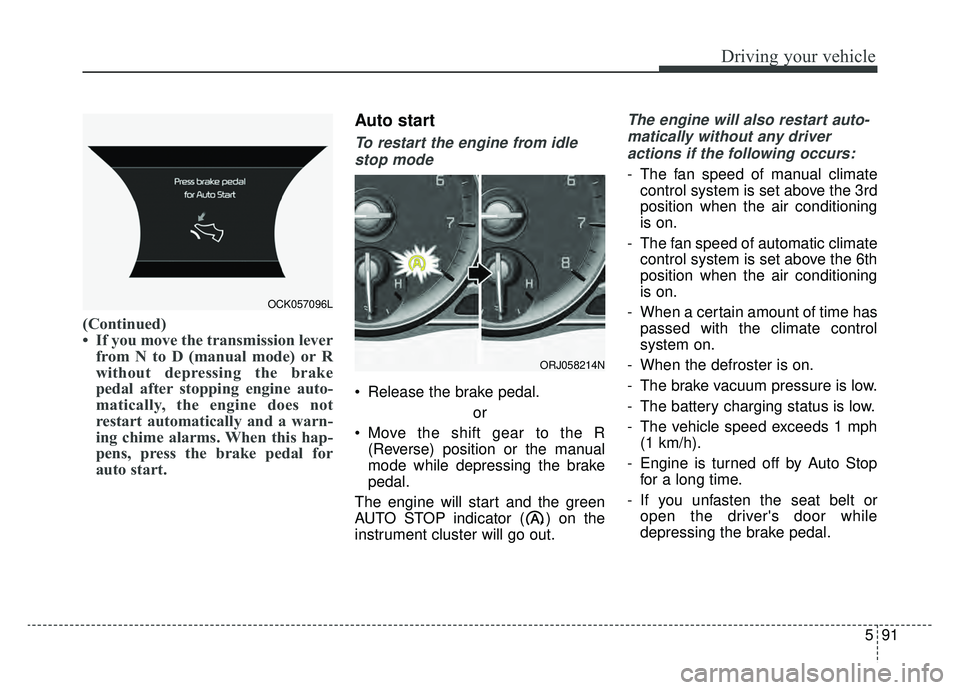
591
Driving your vehicle
(Continued)
• If you move the transmission leverfrom N to D (manual mode) or R
without depressing the brake
pedal after stopping engine auto-
matically, the engine does not
restart automatically and a warn-
ing chime alarms. When this hap-
pens, press the brake pedal for
auto start.
Auto start
To restart the engine from idle
stop mode
Release the brake pedal.
or
Move the shift gear to the R (Reverse) position or the manual
mode while depressing the brake
pedal.
The engine will start and the green
AUTO STOP indicator ( ) on the
instrument cluster will go out.
The engine will also restart auto- matically without any driveractions if the following occurs:
- The fan speed of manual climate control system is set above the 3rd
position when the air conditioning
is on.
- The fan speed of automatic climate control system is set above the 6th
position when the air conditioning
is on.
- When a certain amount of time has passed with the climate control
system on.
- When the defroster is on.
- The brake vacuum pressure is low.
- The battery charging status is low.
- The vehicle speed exceeds 1 mph (1 km/h).
- Engine is turned off by Auto Stop for a long time.
- If you unfasten the seat belt or open the driver's door while
depressing the brake pedal.
OCK057096L
ORJ058214N
Page 361 of 580
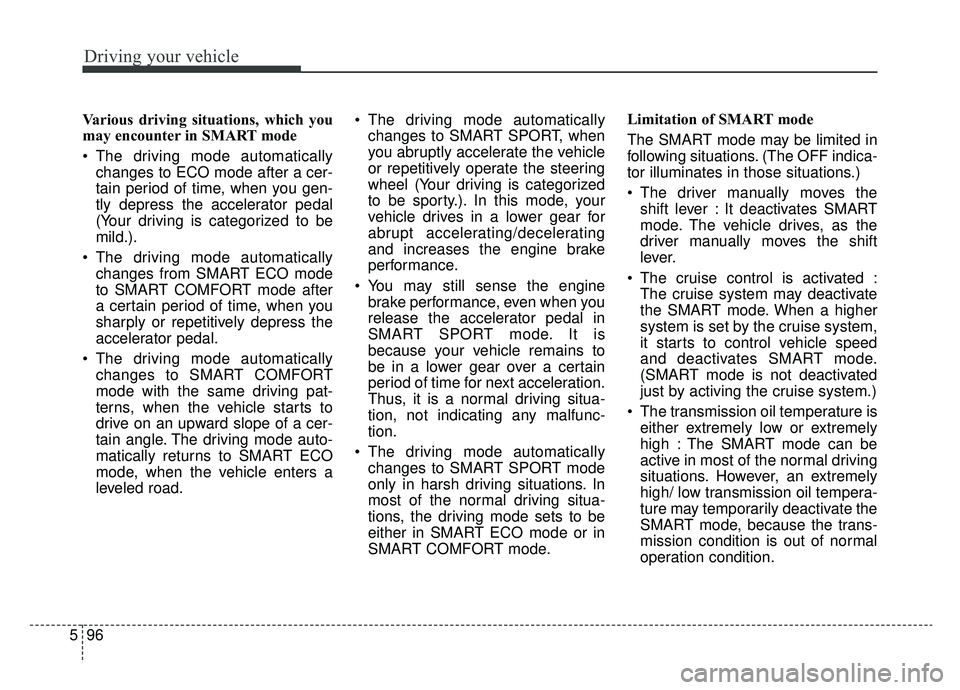
Driving your vehicle
96
5
Various driving situations, which you
may encounter in SMART mode
The driving mode automatically
changes to ECO mode after a cer-
tain period of time, when you gen-
tly depress the accelerator pedal
(Your driving is categorized to be
mild.).
The driving mode automatically changes from SMART ECO mode
to SMART COMFORT mode after
a certain period of time, when you
sharply or repetitively depress the
accelerator pedal.
The driving mode automatically changes to SMART COMFORT
mode with the same driving pat-
terns, when the vehicle starts to
drive on an upward slope of a cer-
tain angle. The driving mode auto-
matically returns to SMART ECO
mode, when the vehicle enters a
leveled road. The driving mode automatically
changes to SMART SPORT, when
you abruptly accelerate the vehicle
or repetitively operate the steering
wheel (Your driving is categorized
to be sporty.). In this mode, your
vehicle drives in a lower gear for
abrupt accelerating/decelerating
and increases the engine brake
performance.
You may still sense the engine brake performance, even when you
release the accelerator pedal in
SMART SPORT mode. It is
because your vehicle remains to
be in a lower gear over a certain
period of time for next acceleration.
Thus, it is a normal driving situa-
tion, not indicating any malfunc-
tion.
The driving mode automatically changes to SMART SPORT mode
only in harsh driving situations. In
most of the normal driving situa-
tions, the driving mode sets to be
either in SMART ECO mode or in
SMART COMFORT mode. Limitation of SMART mode
The SMART mode may be limited in
following situations. (The OFF indica-
tor illuminates in those situations.)
The driver manually moves the
shift lever : It deactivates SMART
mode. The vehicle drives, as the
driver manually moves the shift
lever.
The cruise control is activated : The cruise system may deactivate
the SMART mode. When a higher
system is set by the cruise system,
it starts to control vehicle speed
and deactivates SMART mode.
(SMART mode is not deactivated
just by activing the cruise system.)
The transmission oil temperature is either extremely low or extremely
high : The SMART mode can be
active in most of the normal driving
situations. However, an extremely
high/ low transmission oil tempera-
ture may temporarily deactivate the
SMART mode, because the trans-
mission condition is out of normal
operation condition.
Page 363 of 580
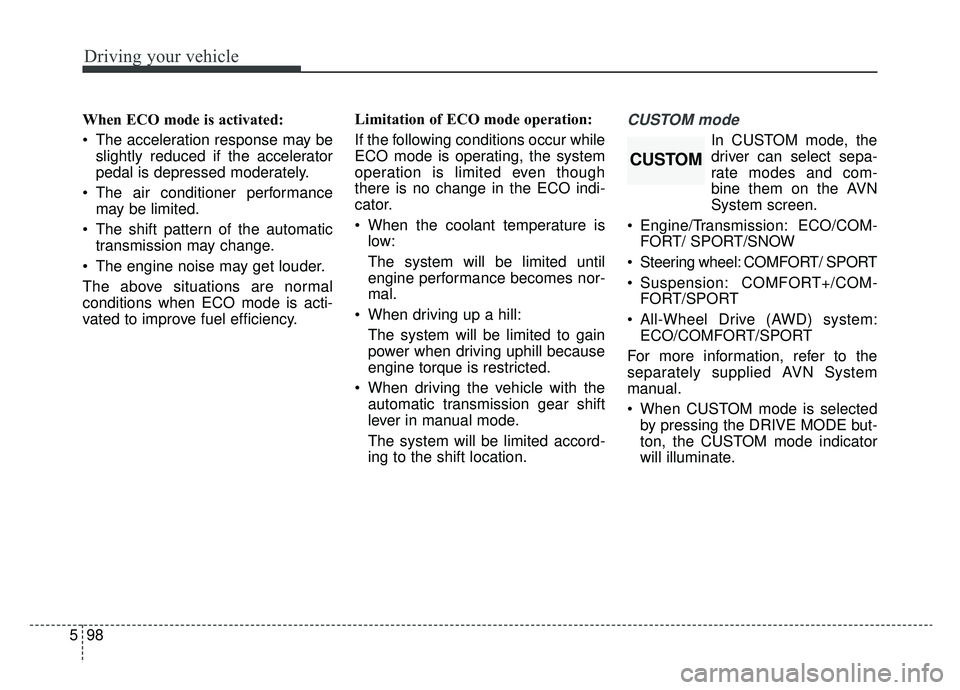
Driving your vehicle
98
5
When ECO mode is activated:
The acceleration response may be
slightly reduced if the accelerator
pedal is depressed moderately.
The air conditioner performance may be limited.
The shift pattern of the automatic transmission may change.
The engine noise may get louder.
The above situations are normal
conditions when ECO mode is acti-
vated to improve fuel efficiency. Limitation of ECO mode operation:
If the following conditions occur while
ECO mode is operating, the system
operation is limited even though
there is no change in the ECO indi-
cator.
When the coolant temperature is
low:
The system will be limited until
engine performance becomes nor-
mal.
When driving up a hill: The system will be limited to gain
power when driving uphill because
engine torque is restricted.
When driving the vehicle with the automatic transmission gear shift
lever in manual mode.
The system will be limited accord-
ing to the shift location.CUSTOM mode
In CUSTOM mode, the
driver can select sepa-
rate modes and com-
bine them on the AVN
System screen.
Engine/Transmission: ECO/COM- FORT/ SPORT/SNOW
Steering wheel: COMFORT/ SPORT
Suspension: COMFORT+/COM- FORT/SPORT
All-Wheel Drive (AWD) system: ECO/COMFORT/SPORT
For more information, refer to the
separately supplied AVN System
manual.
When CUSTOM mode is selected by pressing the DRIVE MODE but-
ton, the CUSTOM mode indicator
will illuminate.
CUSTOM
Page 567 of 580
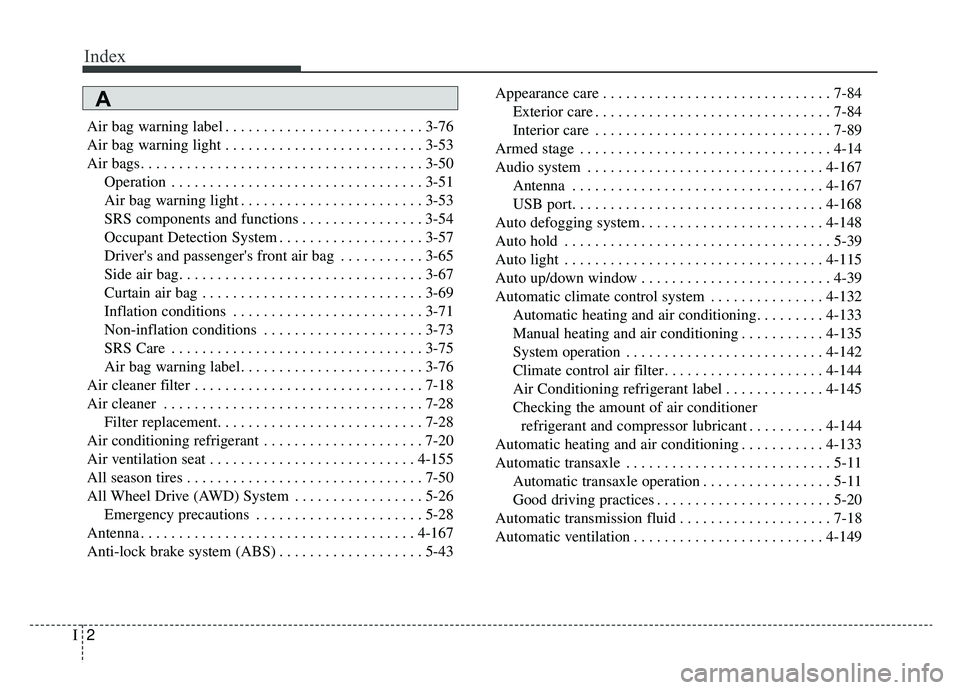
Index
2I
Air bag warning label . . . . . . . . . . . . . . . . . . . . . . . . . . 3-76
Air bag warning light . . . . . . . . . . . . . . . . . . . . . . . . . . 3-53
Air bags. . . . . . . . . . . . . . . . . . . . . . . . . . . . . . . . . . . . \
. 3-50Operation . . . . . . . . . . . . . . . . . . . . . . . . . . . . . . . . . 3-51
Air bag warning light . . . . . . . . . . . . . . . . . . . . . . . . 3-53
SRS components and functions . . . . . . . . . . . . . . . . 3-54
Occupant Detection System . . . . . . . . . . . . . . . . . . . 3-57
Driver's and passenger's front air bag . . . . . . . . . . . 3-65
Side air bag. . . . . . . . . . . . . . . . . . . . . . . . . . . . . . . . 3-67
Curtain air bag . . . . . . . . . . . . . . . . . . . . . . . . . . . . . 3-69
Inflation conditions . . . . . . . . . . . . . . . . . . . . . . . . . 3-71
Non-inflation conditions . . . . . . . . . . . . . . . . . . . . . 3-73
SRS Care . . . . . . . . . . . . . . . . . . . . . . . . . . . . . . . . . 3-75
Air bag warning label. . . . . . . . . . . . . . . . . . . . . . . . 3-76
Air cleaner filter . . . . . . . . . . . . . . . . . . . . . . . . . . . . . . 7-18
Air cleaner . . . . . . . . . . . . . . . . . . . . . . . . . . . . . . . . . . 7-28\
Filter replacement. . . . . . . . . . . . . . . . . . . . . . . . . . . 7-28
Air conditioning refrigerant . . . . . . . . . . . . . . . . . . . . . 7-20
Air ventilation seat . . . . . . . . . . . . . . . . . . . . . . . . . . . 4-155
All season tires . . . . . . . . . . . . . . . . . . . . . . . . . . . . . . . 7-50
All Wheel Drive (AWD) System . . . . . . . . . . . . . . . . . 5-26 Emergency precautions . . . . . . . . . . . . . . . . . . . . . . 5-28
Antenna . . . . . . . . . . . . . . . . . . . . . . . . . . . . . . . . . . . . \
4-167
Anti-lock brake system (ABS) . . . . . . . . . . . . . . . . . . . 5-43 Appearance care . . . . . . . . . . . . . . . . . . . . . . . . . . . . . . 7-84
Exterior care . . . . . . . . . . . . . . . . . . . . . . . . . . . . . . . 7-84
Interior care . . . . . . . . . . . . . . . . . . . . . . . . . . . . . . . 7-89
Armed stage . . . . . . . . . . . . . . . . . . . . . . . . . . . . . . . . . 4-14
Audio system . . . . . . . . . . . . . . . . . . . . . . . . . . . . . . . 4-167 Antenna . . . . . . . . . . . . . . . . . . . . . . . . . . . . . . . . . 4-167
USB port. . . . . . . . . . . . . . . . . . . . . . . . . . . . . . . . . 4-168
Auto defogging system . . . . . . . . . . . . . . . . . . . . . . . . 4-148
Auto hold . . . . . . . . . . . . . . . . . . . . . . . . . . . . . . . . . . . 5-\
39
Auto light . . . . . . . . . . . . . . . . . . . . . . . . . . . . . . . . . . 4-11\
5
Auto up/down window . . . . . . . . . . . . . . . . . . . . . . . . . 4-39
Automatic climate control system . . . . . . . . . . . . . . . 4-132 Automatic heating and air conditioning. . . . . . . . . 4-133
Manual heating and air conditioning . . . . . . . . . . . 4-135
System operation . . . . . . . . . . . . . . . . . . . . . . . . . . 4-142
Climate control air filter. . . . . . . . . . . . . . . . . . . . . 4-144
Air Conditioning refrigerant label . . . . . . . . . . . . . 4-145
Checking the amount of air conditioner refrigerant and compressor lubricant . . . . . . . . . . 4-144
Automatic heating and air conditioning . . . . . . . . . . . 4-133
Automatic transaxle . . . . . . . . . . . . . . . . . . . . . . . . . . . 5-11 Automatic transaxle operation . . . . . . . . . . . . . . . . . 5-11
Good driving practices . . . . . . . . . . . . . . . . . . . . . . . 5-20
Automatic transmission fluid . . . . . . . . . . . . . . . . . . . . 7-18
Automatic ventilation . . . . . . . . . . . . . . . . . . . . . . . . . 4-149
A